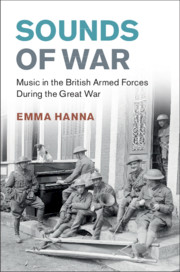Book contents
- Sounds of War
- Studies in the Social and Cultural History of Modern Warfare
- Sounds of War
- Copyright page
- Dedication
- Contents
- Figures
- Acknowledgements
- Abbreviations
- Introduction
- 1 Music in Britain, 1914
- 2 Recruitment and Fundraising
- 3 Instruments of War
- 4 Songs, Identity and Morale
- 5 Captivity
- 6 Religion and Pastoral Care
- 7 Medicine and Therapy
- 8 The Gramophone
- 9 Civilian Concert Parties
- 10 Servicemen’s Concert Parties
- 11 After the Armistice
- Conclusion
- Notes
- Sources and Select Bibliography
- Index
5 - Captivity
Published online by Cambridge University Press: 20 February 2020
- Sounds of War
- Studies in the Social and Cultural History of Modern Warfare
- Sounds of War
- Copyright page
- Dedication
- Contents
- Figures
- Acknowledgements
- Abbreviations
- Introduction
- 1 Music in Britain, 1914
- 2 Recruitment and Fundraising
- 3 Instruments of War
- 4 Songs, Identity and Morale
- 5 Captivity
- 6 Religion and Pastoral Care
- 7 Medicine and Therapy
- 8 The Gramophone
- 9 Civilian Concert Parties
- 10 Servicemen’s Concert Parties
- 11 After the Armistice
- Conclusion
- Notes
- Sources and Select Bibliography
- Index
Summary
Demonstrates that music was a vital part of the daily routines of those interned in prisoner of war camps. The forming of orchestras and theatrical revues were a popular way of passing the time and maintaining morale, but in many cases musical activities were used by prisoners of war to conceal attempts to escape. This chapter will give examples of how prisoners of war used music as a means of keeping up their morale to stave off feelings of ‘mouldiness,’ later identified as barbed wire disease.
Keywords
- Type
- Chapter
- Information
- Sounds of WarMusic in the British Armed Forces during the Great War, pp. 95 - 113Publisher: Cambridge University PressPrint publication year: 2020

